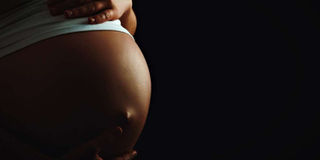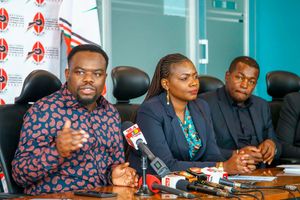How Kenya paved the way for uterus transplants

A pregnant woman. Globally, live uterus donors are family members or close friends. PHOTO | FOTOSEARCH
What you need to know:
- In 2013, the first pregnancy after a uterus transplant in a human was recorded
- The next year, the first baby born after that uterus transplant was born in Sweden
- To date, there have been 40 uterus transplants globally
- While no uterus transplants have been done in Africa, “much of the pre-clinical work” on uterus transplants was done at the Kenya-based Institute of Primate Research in Nairobi
Babies. Some women have them, while others yearn for them but can’t have them. In Kenya, about 10 to 15 per cent of the population is affected by infertility, and for some, it is for lack of a womb.
Some women are born without a uterus; some have a dysfunctional one, while others have theirs removed to treat fibroids, cervical cancer or an infection.
For many years, there was no possibility that they would carry a pregnancy, up until 2013, when the first pregnancy after a uterus transplant in a human was recorded, and the next year, the first baby born after that uterus transplant was born in Sweden, a country lauded as the pioneer of uterus transplant surgeries.
The recipient, a 35-year-old woman was born without a vagina and a womb due to Mayer-Rokitansky-Küster-Hauser (MRKH) syndrome, but she had functioning ovaries. The womb donor was a 62-year-old postmenopausal family friend, who had gone for 12 consecutive months without a period. MRKH, named after the four German doctors who discovered it, is a disorder in which a woman has a dysfunctional or no vagina and uterus. It affects one in 4,500 women, and because they don’t have a uterus, they usually don’t have menstrual periods.
To date, there have been 40 uterus transplants globally in Sweden, United States, Brazil, Lebanon, Serbia, India and China. And while no uterus transplants have been done in Africa, “much of the pre-clinical work” on uterus transplants was done at the Kenya-based Institute of Primate Research in Nairobi, says Mats Brännström of the Department of Obstetrics and Gynaecology at the University of Gothenburg in Sweden and President of the International Society of Uterus Transplantation, which keeps a registry of uterus transplants done in the world.
Nearly a decade ago, the institute set the foundation for the delicate but ground-breaking procedure. The first trials to ascertain whether uterus transplants were viable were carried out in 2009 at the facility through studies on female olive baboons.
Before medical procedures are carried out in humans, they are tried out in animals to learn how, for instance, the procedure would be carried out, method to use and possible outcomes. At first, uterus transplants were carried out in rodents, sheep and pigs, then once found to be feasible, moved to non-human primates – in this case baboons, because of their relatively large size and because their uterus structure and reproductive system resembles that of humans.
In 2009, Senior Research Scientist Atunga Nyachieo was part of a team of eight (three Kenyans and five Swedes) who carried out uterus transplant trials in 15 olive baboons in Nairobi. Five baboons helped the scientists understand pelvic anatomy, while 10 got actual transplants. The findings were published in a 2010 paper titled Uterus transplantation in the baboon: methodology and long-term function after auto-transplantation.
“The procedure involved retrieval of the uterus from the baboon and returning it to the same baboon, or what is called auto-transplantation,” Dr Nyachieo told Healthy Nation.
One baboon died the first night after surgery due to cardiomyopathy, that is, her heart muscles weakened and thus could not pump blood. Five of the nine surviving animals resumed their normal menstruation cycle.
The paper noted the complexity of the surgery and thus recommended “further methodological developments” which led to modification and refining, and eventually human uterus transplants. By last year, at least 17 babies had been born following uterus transplants.
The most recent births — deliveries after the 15th and 17th transplants — were in March and May this year, at Tübingen University Hospital, Germany. The two women — aged 25 and 26 years — were both born with MRKH syndrome and got their uteri from their mothers. The wombs were implanted at the University Hospital in Gothenburg, Sweden. Both women had a vagina (also called a neovagina) created, by stretching vaginal tissue. This allowed them to get a uterus transplant, because in humans, the transplant involves connecting the donor’s uterus and recipient’s veins and arteries, ligaments, and vaginal canals. Both pregnancies, as in the case of the first successful one, were possible through artificial insemination (eggs were fertilised outside their body using their husband’s/partners sperm and then transferred to their new wombs for implantation). The births were through Caesarean section to avoid strain on the sewn-in organ during labour. One of the new mothers, a 26-year-old identified as Julia W experienced her first menstrual period six weeks after the womb transplant. A battery of tests later confirmed that her new organ was functioning fine. Following artificial insemination, she got pregnant and nine months later, she gave birth to a baby boy.
Her doctors believe she can become pregnant again. “However, we’ll remove the uterus at the latest after the second child,” said her transplant surgeon Alfred Königsrainer.
This is because after a transplant, an organ recipient takes immunosuppressant drugs to prevent their immune systems from rejecting the new organ. However, these drugs are potent and can affect a pregnancy, therefore, the uterus is best removed after a birth.
But the procedure which traces its history in Kenya has yet to take off locally to help women who might need it. Maureen Owiti, a Nairobi-based gynaecologist says she has encountered two confirmed MRKH cases in her 16 years of practice.
“There is a high possibility that surgeons and specialists in Kenya and in Africa are not aware that this technology is available and is being practised. Thus there is need to not only create awareness, but also to provide training on this skill,” Dr Nyachieo told Healthy Nation.
“The other reason we are yet to have our first uterus transplant in the country is because no one is asking for it. Women dealing with infertility and who might need a uterus transplant do not know that this is an option. I hope people will now know that what is happening globally can happen here. We just need to build the capacity of our experts,” he added.
Globally, live uterus donors are usually family members or close friends, but they are not easy to come by. In December 2018, Brazil scored a world first following a uterus transplant from a dead donor. In this case as in the others, the 32-year-old recipient was born with MRKH disorder. She underwent uterine transplant on September 20, 2016 at Hospital das Clínicas, University of São Paulo, Brazil. She received the uterus from a 45-year-old donor — who had given birth, vaginally, three times. The donor's heart, liver, and kidneys were donated to other recipients. The uterus was removed from the donor and then transplanted into the recipient during a 10-and-a-half-hour surgery. There have been 10 other uterus transplants from deceased donors attempted in the USA, Czech Republic and Turkey, but the one in Brazil was the first to result in a live birth. Advances in the area have also seen robot-assisted uterus transplants that resulted in a baby boy born via C-Section in Sweden in April. The uterine transplant was done through robot-assisted keyhole surgery that was "considerably less invasive" for the donor who was the recipient’s mother. The donor was operated on through one-centimetre incisions in the abdomen. The robotic arms holding the surgical instruments were guided by two surgeons, one on each side of the patient. Each surgeon sat at a workstation a few metres away, with a joystick-like tool and magnified 3D screen image that allowed immense precision for operating deep inside the lower abdomen.
Towards the end of the procedure, another incision was made to remove the uterus. It was then immediately inserted in the recipient by means of open surgery, during which blood vessels in the recipient were connected to it.
The new technique makes a big difference for donors, who generally feel better afterwards and get back on their feet faster as there is less blood loss.
Another robot-assisted operation was done in China.
There are also discussions on an artificial, bioengineered uterus developed from stem cells from a woman’s body, though this is in the early stages of experiments with rats. If this is successful, it would mean donors would no longer be necessary.
In the midst of the breakthroughs, questions on whether a uterus can be transplanted in men, allowing them to carry a pregnancy and deliver a baby may arise as an ethical frontier that research has to deal with. There are also questions about the risks of the surgery especially to the recipient and the potential negative effects of the immunosuppressant drugs as well as social and legal challenges for the parties (donor, the recipient and the intended child) and if there are risks for children born from a transplanted uterus.
There are also concerns about the costs associated with such transplants, and whether insurance will cover costs or whether women will pay out of pocket. Analysis shows the procedures conducted in Europe and in the United States, may cost anything from Sh5.6 million to Sh20 million.
Questions such as whether the procedure is essential also arise. Kidney, heart, lungs, liver transplants, save lives of people with life-threatening disease, but not so for transplants of the uterus – a muscular hollow organ – which only offer hope for women who want to bring forth life. In research circles, the procedure is compared to hand and facial transplants: they enhance quality-of-life, but are not vital. “You don’t need a womb to stay alive, but it is essential if you want to have children. The absence of this organ and the childlessness that follows can mean huge psychological suffering for the women,” says Professor Sara Brucker, a uterus transplant expert and the Managing Medical Director of the Department of Gynaecology and Obstetrics at Tübingen University Hospital.
Moreover, as Dr Nyachieo adds, while women suffering infertility and their partners have the option of adoption or surrogacy, these are also marked with ethical, religious, cultural and legal issues. “The uterus transplant addresses some of these concerns,” he told Healthy Nation.



